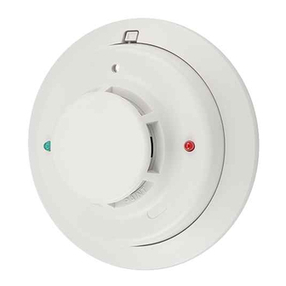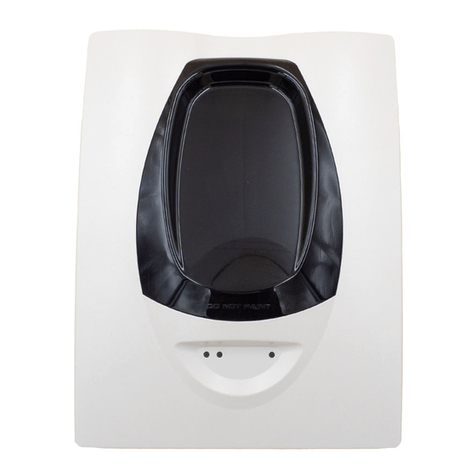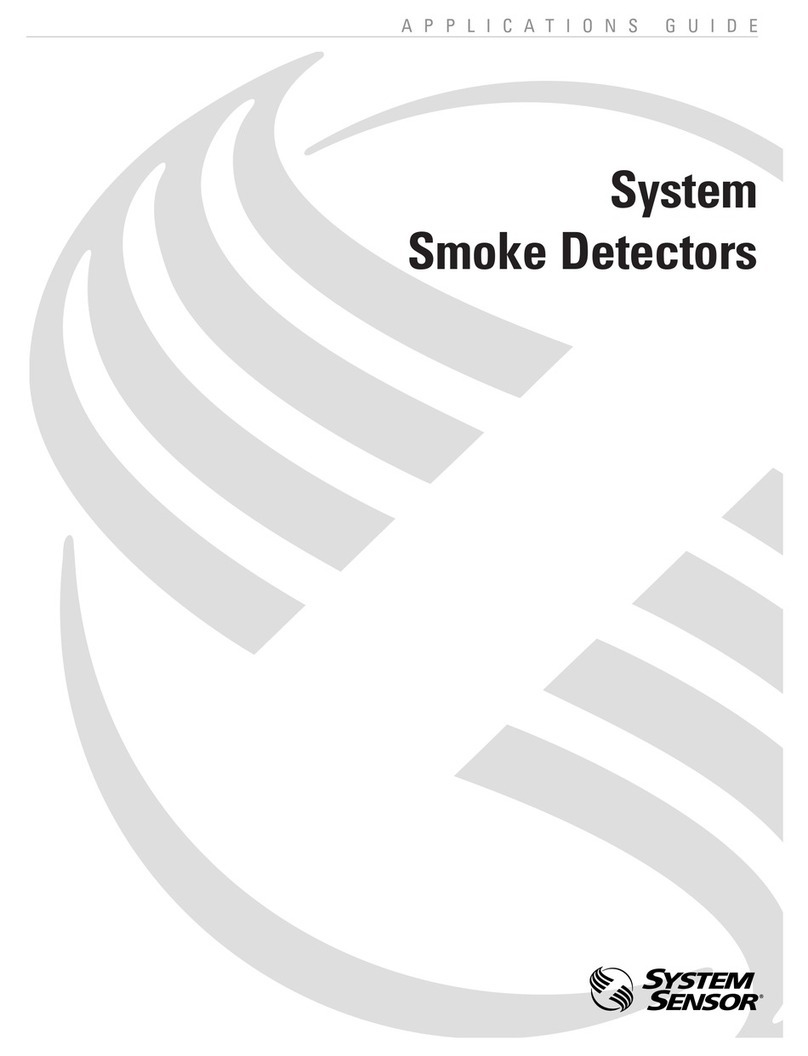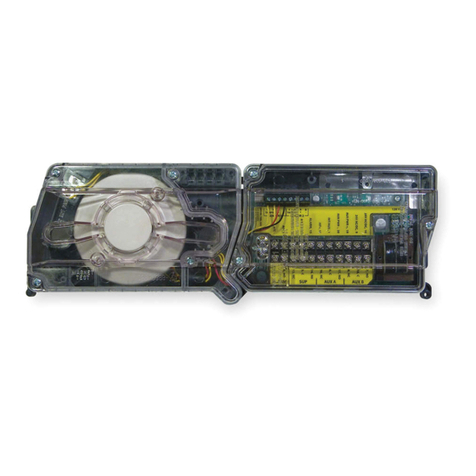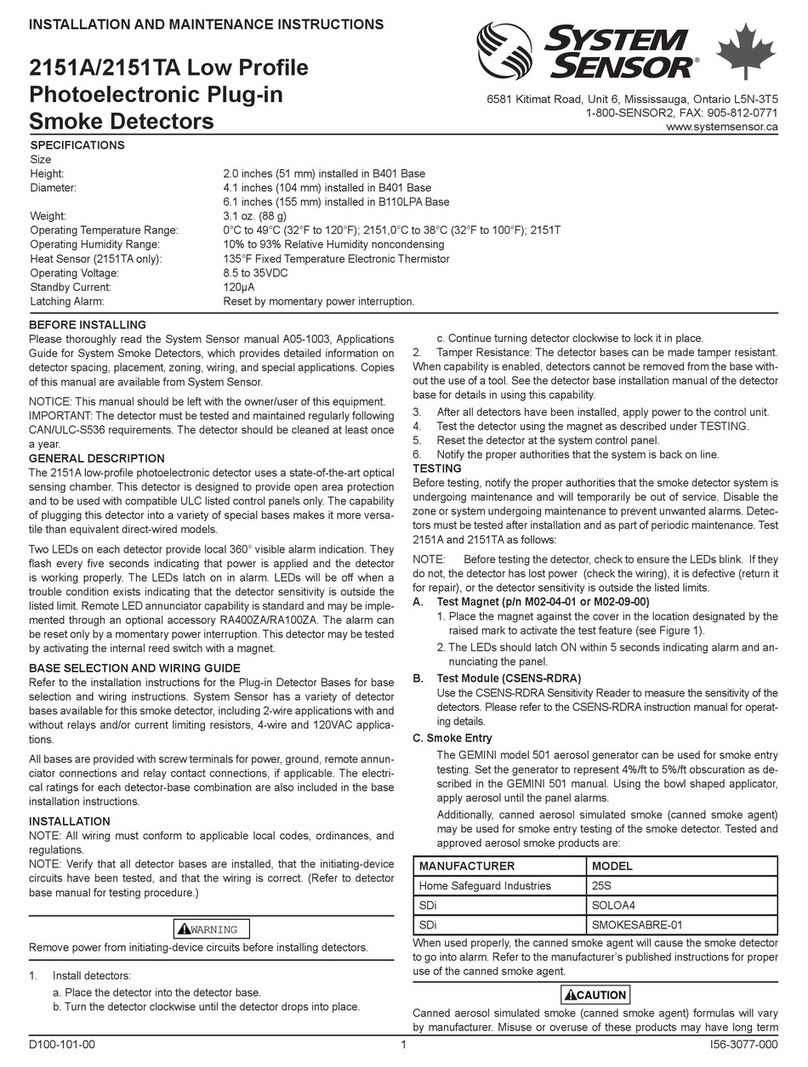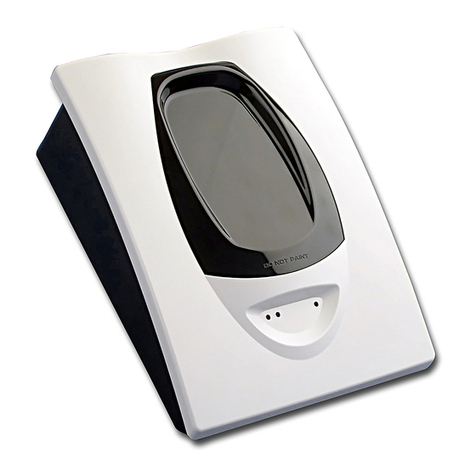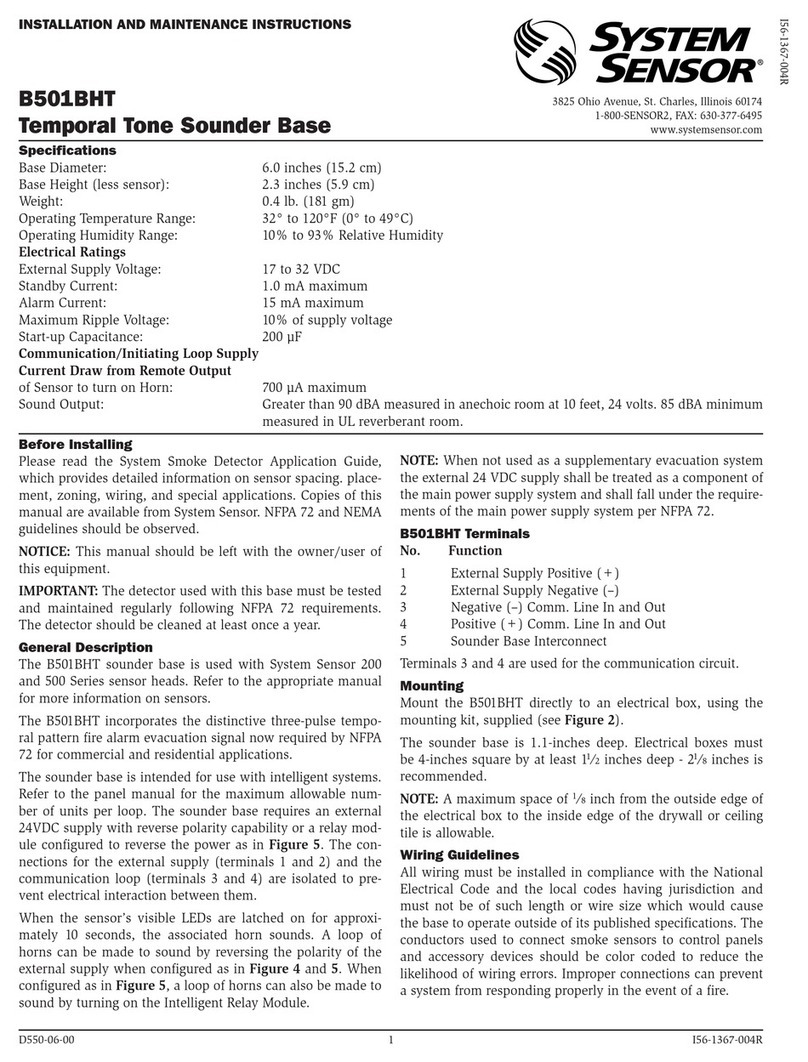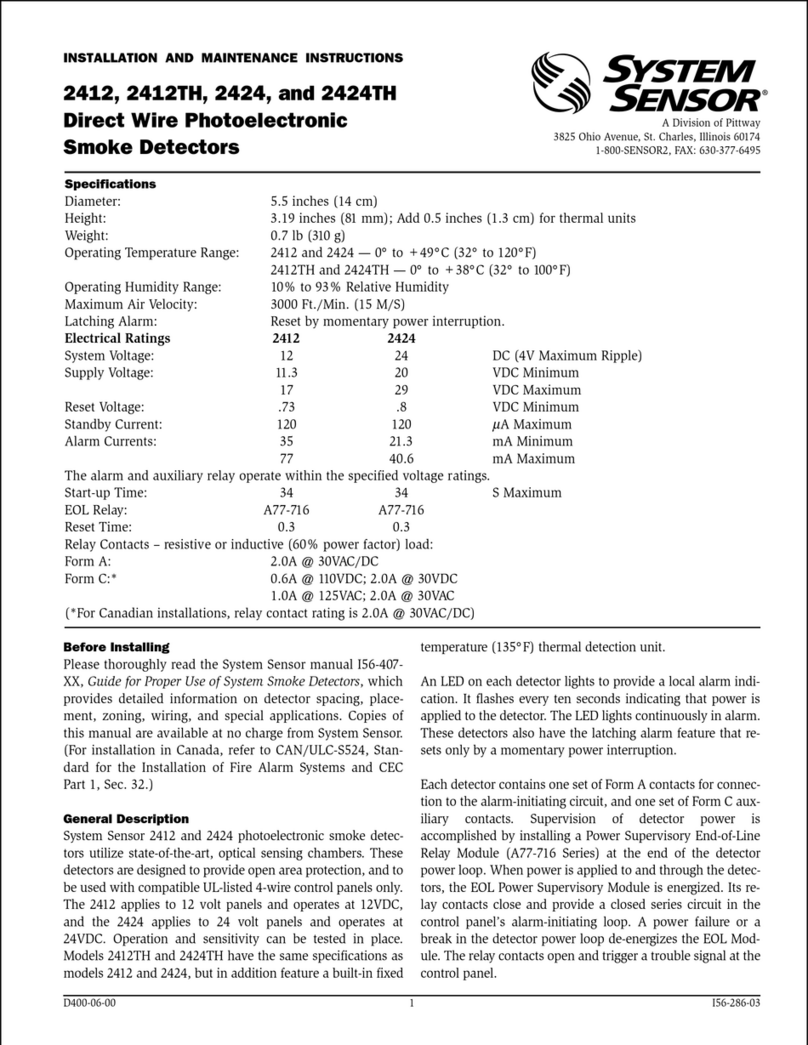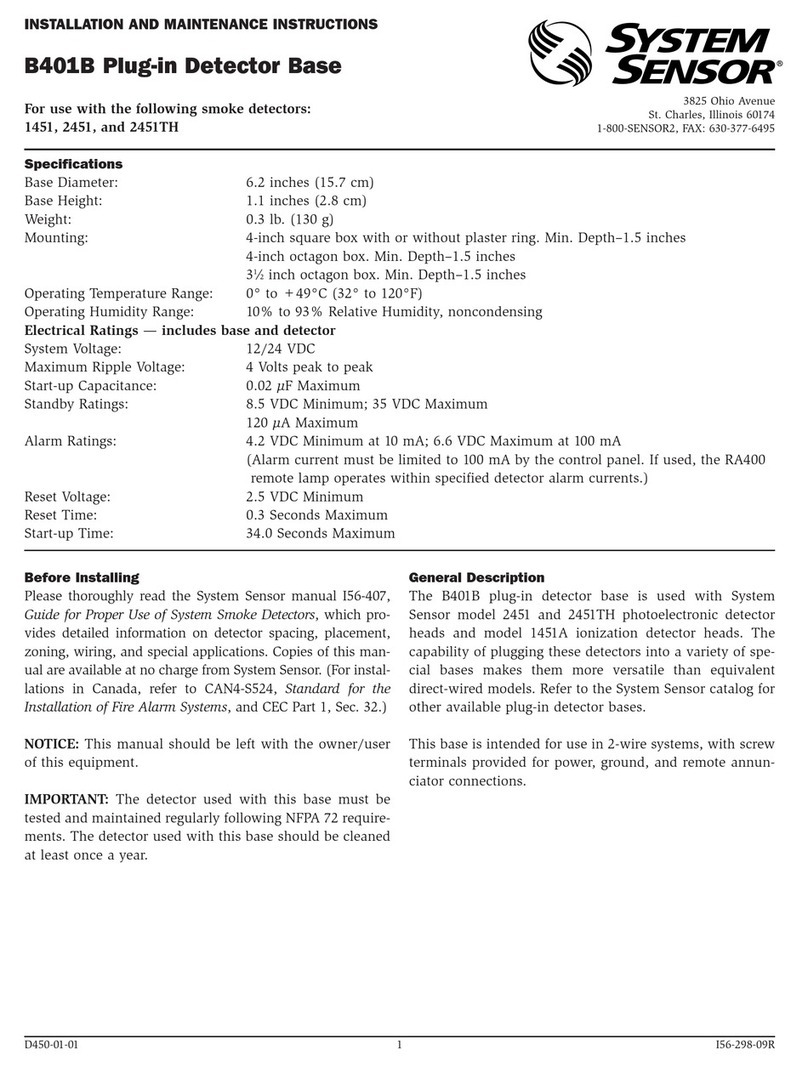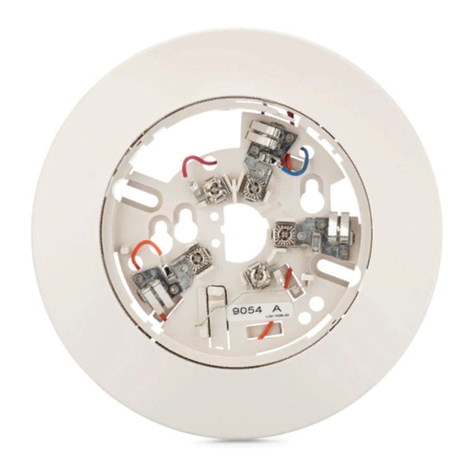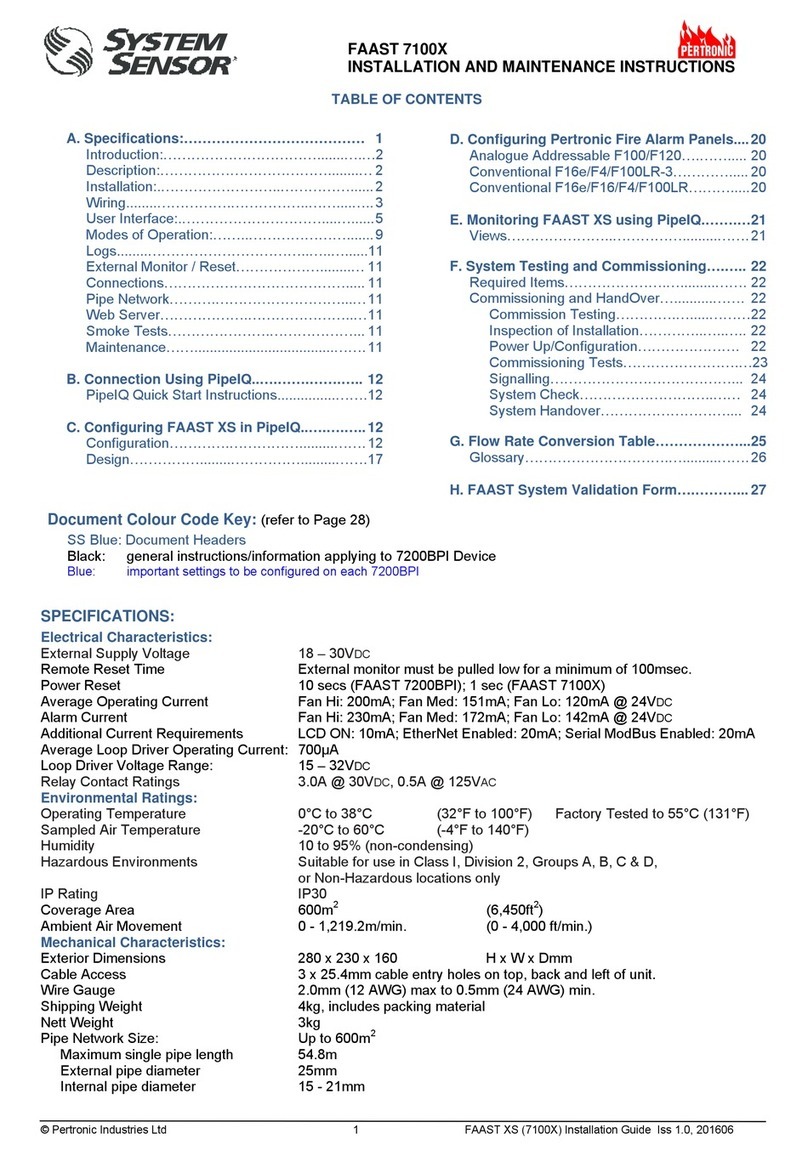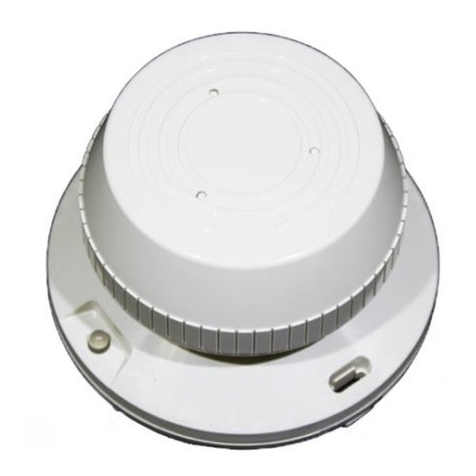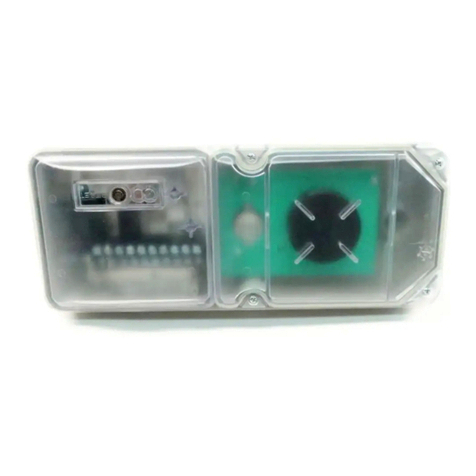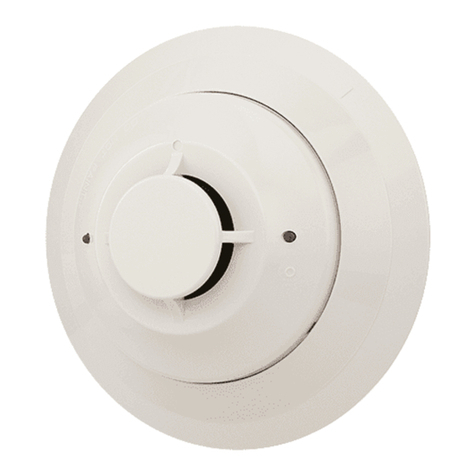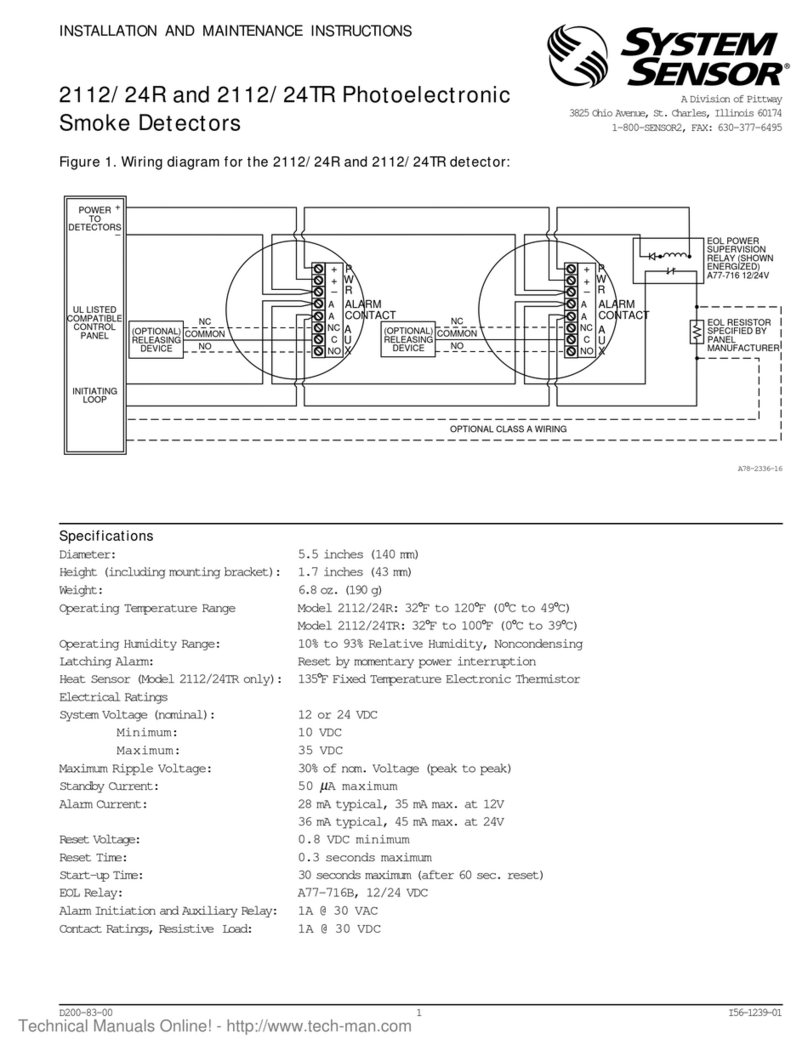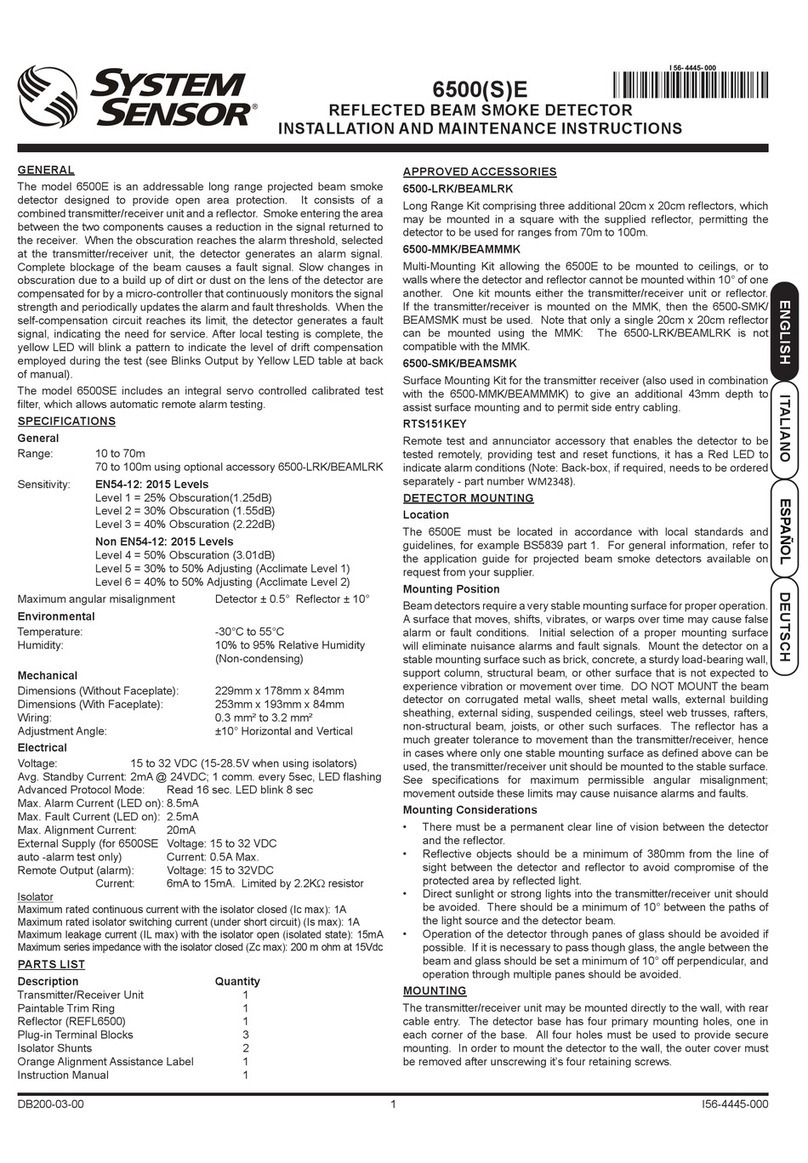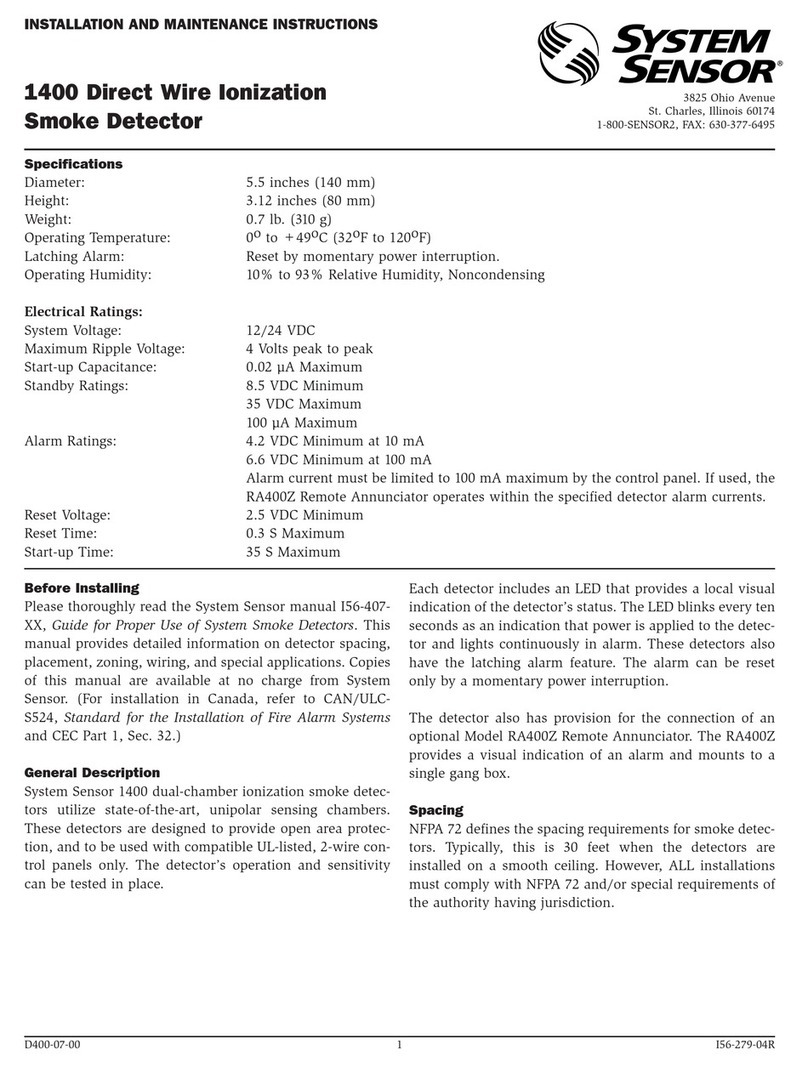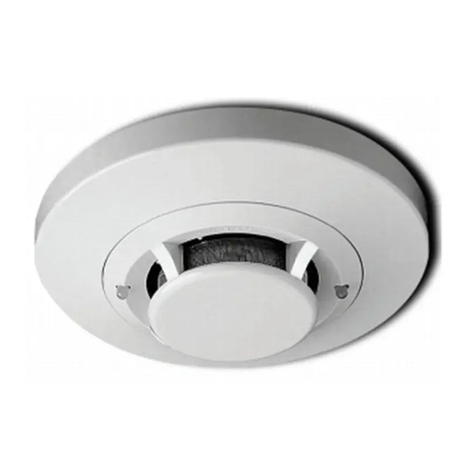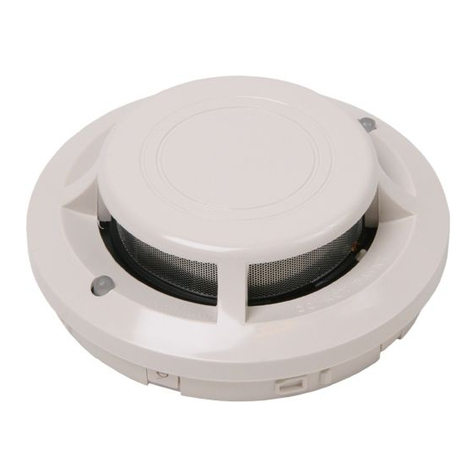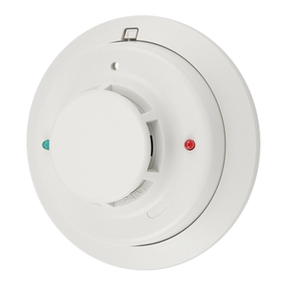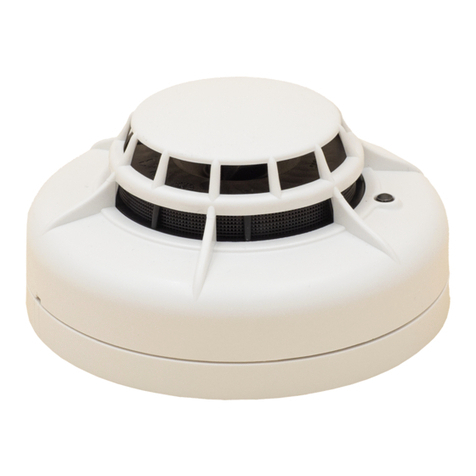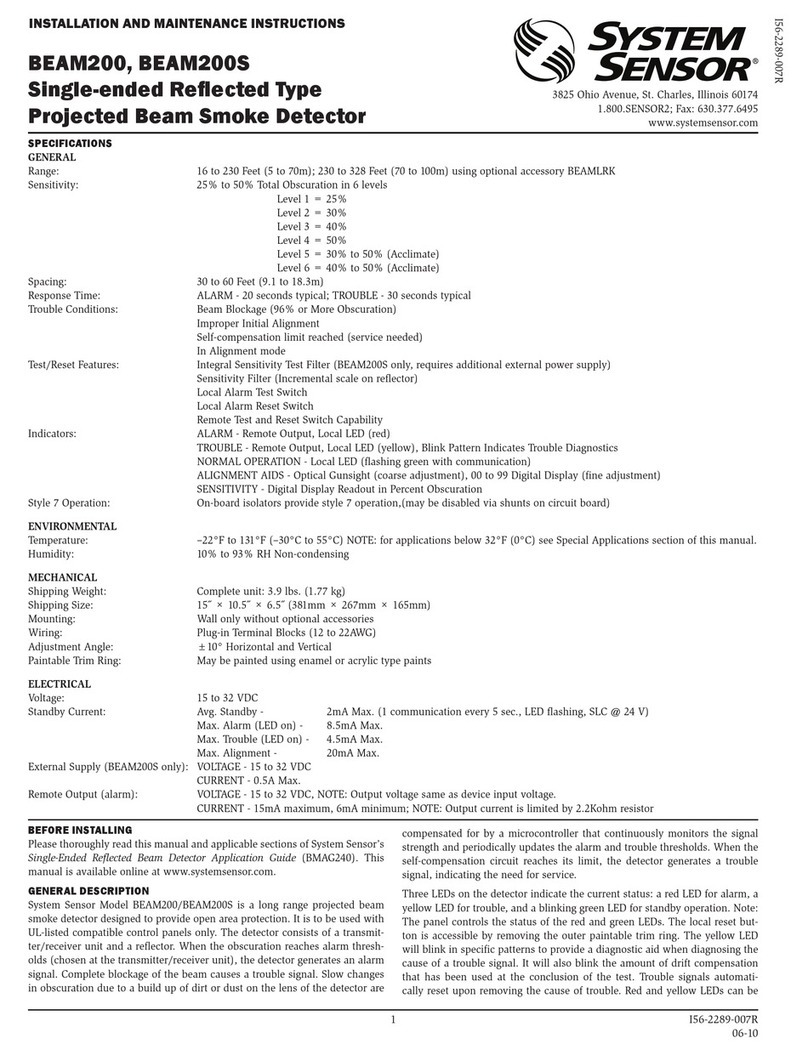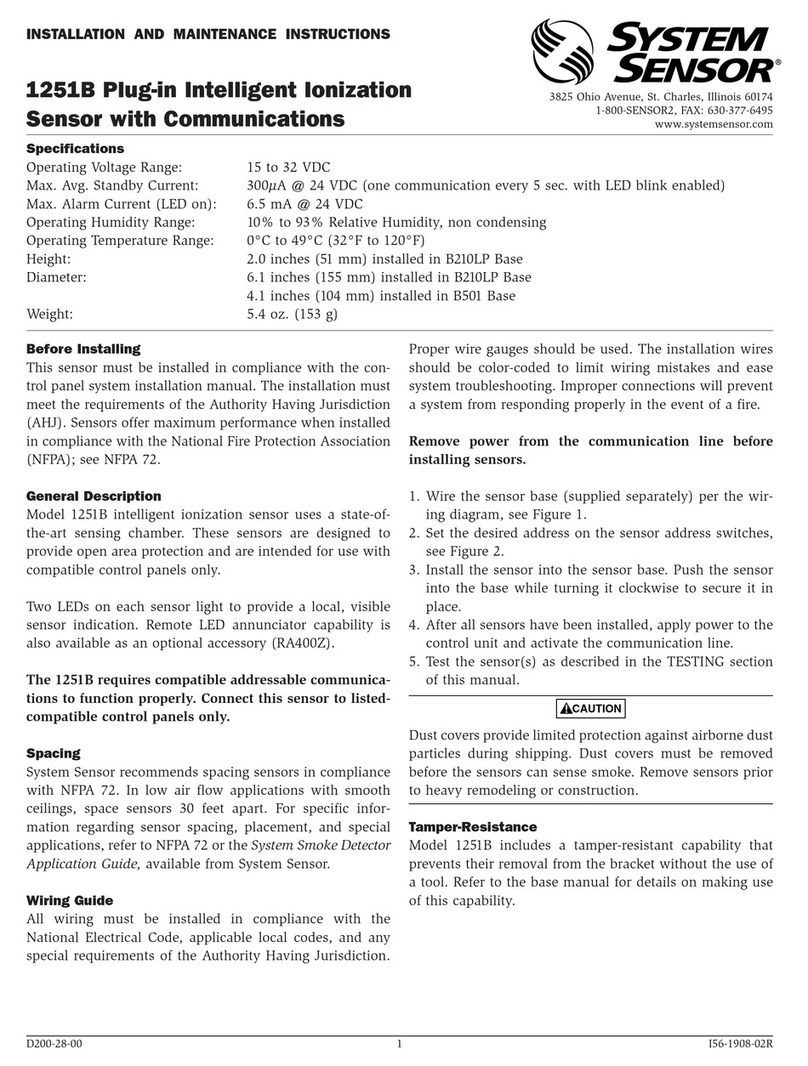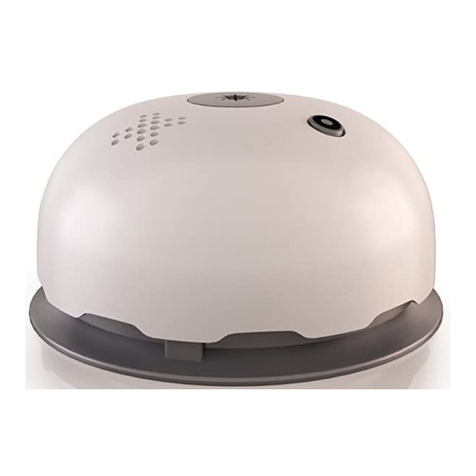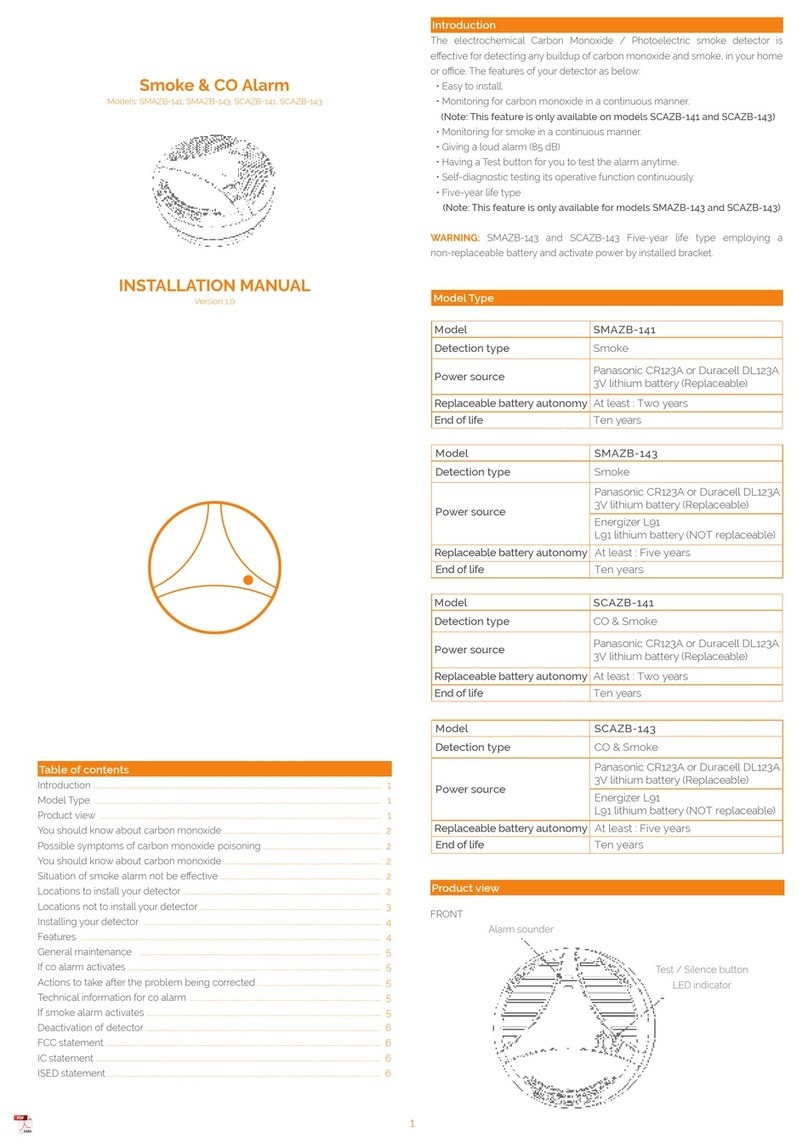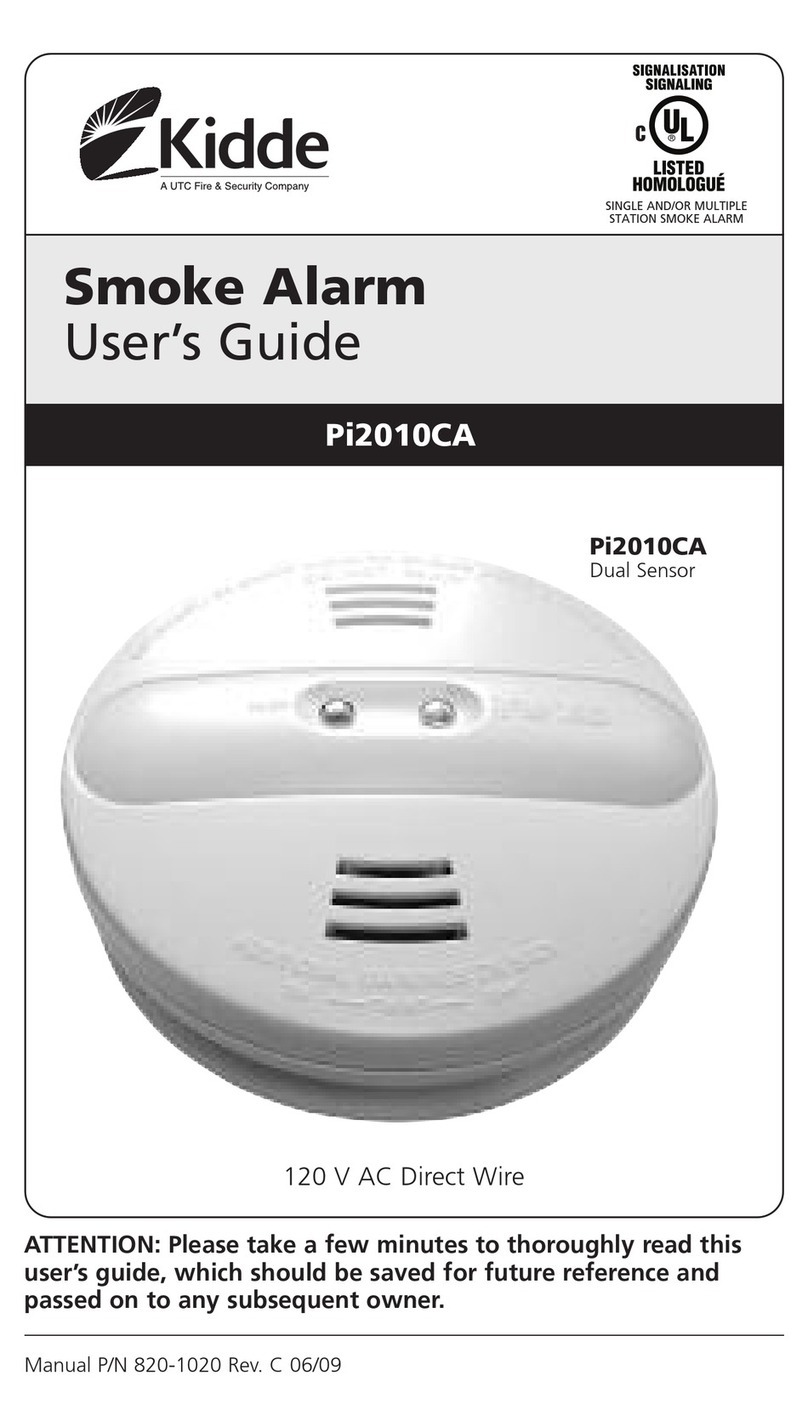
●DANGER: If the alarm horn sounds a smoke alarm and you are not
testing the unit, the smoke alarm has sensed smoke or combustion
articles in the air. THE ALARM HORN IS A WARNING OF A
POSSIBLY SERIOUS SITUATION. IT REQUIRES YOUR
IMMEDIATE ATTENTION.
The alarm could be caused by a nuisance situation. Cooking smoke or a
dusty furnace can cause the smoke alarm to sound. If this happens, open
a window or fan the air to remove the smoke or dust. The smoke alarm
will turn itself off as soon as the air is completely clear.
DO NOT OFF POWER TO THE SMOKE ALARM. THIS WILL
REMOVE YOUR PROTECTION.
Figure 9
:
●
PU
H
O SILENCE
PUSH AND HOLD TO TEST LED
Monitorin
our Smoke alarm
Once the smoke-alarm is energized from an external power, a green LED flashes once
about 40 seconds. This signals that the smoke alarm is receiving power and is in the
detection mode. If the smoke alarm is not operating properly, the green LED will be OFF.
(If so, have the smoke alarm repaired or replaced immediately.) When the
smoke alarm senses smoke, the green LED will flash rapidly. If the initiating
smoke alarm senses smoke and signals other interconnected smoke alarms to
sound their alarm horns, their LEDs will stop flashing. See TABLE 2 for specific
LED functions.
TABLE 2: SMOKE-ALARM STATUS
Connecting Auxiliary Devices with Relay
This smoke-alarm has a built-in relay which may be used to activate auxiliary
devices such as bells, horns, and door closers. The relay contacts automatically
close approximately eight (8) seconds after the unit goes into alarm, and
automatically resets approximately five (5) seconds after the alarm stops. For
wiring refer to Figure 8. Auxiliary voltage and current requirements must be
within relay contact ratings and appropriate wiring must be used.
How to Interconnect Smoke-Alarms
NOTE: Interconnect smoke alarms within one residential unit only. If smoke-alarms
are interconnected between residential units, nuisance alarms will occur when a
smoke alarm in another residence is tested. The model 2012/24AUS.has
two interconnection modes which are shown in table 1.
TABLE 1: INTERCONNECTION MODES
activated
activated
●Up to twenty-four 2012/24AUS smoke-alarms may be interconnected.
The2012/24AUS smoke-alarms ma
also be interconnected with
2012H(A) when they all work at 12VDC supply voltage. If one smoke-
alarm senses smoke, all of the interconnected units will sound in SIGSND
mode, the relays of the interconnected units will be activate
approximately eight seconds after horns sound in SIGRLY mode. Afte
interconnecting the smoke-alarms, push and hold the test button for more
than 3 seconds on one unit. The alarm horns on all of the other smoke
alarms should sound if they are connected correctly.
If any interconnected smoke-alarm is activated by another unit, it senses
smoke, the unit will go into local alarm state with the LED flashing
quickly.
Connect the smoke-alarms together by interconnecting all the SIGSND
terminals to each other and all GND terminals to each other in SIGSND
mode, and interconnecting all the SIGRLY and GND terminals to eac
other in SIGRLY mode (See Figure 7) . Use 0.75mm or larger two-
conductor standard wire.
If smoke alarms will not be connected. DO NOT use the SIGSND,
SIGRLY and GND terminals.
The LEDs on all smoke alarms should flash once about 40 seconds when
external power is turned on to the smoke alarms. Test smoke alarms after
interconnection wiring are complete.
●
The smoke-alarm will automatically return from Alarm to Normal state when the
reason for alarm, as the presence of smoke, is completely removed.
●
●
●
Cautionary Note: Test interconnection wiring after installation is completed.
Test each unit in a system and make sure all other units alarm.
FAILURE TO OBSERVE ANY OF THESE CONDITION
-S CAN CAUSE SYSTEM MALFUNCTION AND/OR
DAMAGE TO THE SMOKE-ALARMS.
Test i ng Inf o r ma tion
Cleaning and Maintenance
DANGER: Electrical Shock Hazard. Turn off power to the smoke alarm at the
main service panel before cleaning the smoke alarm.
This smoke-alarm has been designed to be as maintenance-free as possible.
However, regular testing (see “Testing” above) and periodic maintenance are
necessary.
To clean the smoke-alarm, turn off power and vacuum the outside of the smoke-
alarm with the soft brush attachment of a vacuum cleaner. Do this at least once
every year, preferably every six months. DO NOT ATTEMPT TO CLEAN
THE SMOKE ALARM IN ANY OTHER WAY.
If the smoke- alarm requires service, do not attempt to service it yourself; this
will void your warranty. Return the smoke-alarm to your local System Sensor
distributor or agent. Enclose a note describing what is wrong with the
smoke-alarm.
Special Note Regarding Smoke-Alarm Protective Guards
Smoke-alarms are not to be used with protective guards or cages unless the
combination has been evaluated by an accredited testing laboratory and found to
to be suitable for that purpose.
Warning: The disused battery must be disposed of in a careful and safe manner
to avoid potential danger.
www.systemsensor.com
●You should test your smoke-alarm at least once a month to assure
yourself of its operation, as recommended by AS3786. Test the smoke
alarm by firmly depressing the test switch located on the smoke-alarm
cover (marked “Push and Hold to Test”) FOR 3 SECONDS. (See
Figure9). The alarm horn should sound, and the LED should flash rapidly.
When the test switch is pushed and held for more than 8 seconds, the
relay will be activated.
In an interconnected system, all of the smoke-alarms should sound thei
alarm horns when any one of the test buttons is pushed. The alarm hor
sounds if the smoke-alarm is working properly. This is the only way to
be sure the smoke-alarm is working. Test the smoke-alarm monthly.
If the smoke-alarm fails to test
ro
erl
, have it re
aired or re
laced
immediately.
●
4I56-2012-00C
Ver. C
Please refer to insert for the Lim
itations of fire alarm systems
Interconnection
Mode
Interconnected
Terminals
Electronic
Horn Relay
SIGSND
SIGSND and
GND
Sound
Only the smoke alarms
in local alarm are
SIGRLY
SIGRLY and
GND
Sound
All the interconnected
smoke alarms are
Smoke-Alarm
Status Electronic Horn LED Relay
Normal Standby Silent Flash every 40
seconds Open
Silence State
Beep every 40
seconds (synchronized
with the LED On)
Flash every 40
seconds Open
Local Alarm
Temporal Tone
Flash rapidly
Closed after
8 seconds
SIGSND Signal
Received Temporal Tone Off Open
SIGRLY Signal
Received Temporal Tone Off Closed after
8 seconds
Failed chamber
test
Beep every 40
seconds(synchronized
with the LED On)
Flash every 10
seconds Open
Low battery
voltage
Beep every 40
seconds(At the middle
of the two LED On
time)
Flash every 40
seconds
Open
SILENCE/TEST
SWITCH
INSTALLATION AND MAINTENANCE INSTRUCTIONS
2012/24AUS Photoelectric Smoke-Alarm
with Integral Temp-3 Sounder
10VDC~30VDC
60uA
50mA
85dB(A)at 3m
24
8minutes or cancel by pressing silence/test button for more than 3 seconds
Sounder Beeps and LED Flashes Green once every 40 secs.
55mm
135mm
220g
0℃to 50℃
5% to 93% R.H.
Specifications
Supply Voltage Range:
Max. Standby Current:
Max. Alarm Current:
P-Horn Sound Output Level:
Max. Interconnected Units:
Silence Mode Timeout Period:
Silence Mode Indication:
Height:
Diameter:
Weight:
Operating Temperature Range:
Humidity:
●
children playing with matches, or arson.
Smoke-alarms are not fool-
roof. Like all electronic devices, smoke alarms
have limitations. No type of smoke-alarm can sense every kind of fire every
time.
Smoke-alarms are not a substitute for life or property insurance. Though
smoke-alarms have been responsible for saving many lives, they are no
warranted or implied to protect lives or property in the event of a fire.
A preventative maintenance agreement should be arranged through the local
manufacturer’s representative. Though smoke-alarms are designed for long
life, they may fail at any time. Therefore, smoke-alarms shall be replace
after being in service for 10 years. Any smoke-alarm, fire alarm equipment,
or any component of that system which fails shall be repaired or replaced as
soon as possible.
General
Description
Smoke-alarms are designed to provide early warning of developing fires at a
reasonable cost. They monitor the air and can sense smoke,
roviding precious
minutes for occupants to escape before a fire spreads. Early warning fire detection is
best achieved by the installation of smoke alarms in all rooms and areas of the
building.
Model 2012/24AUS is a photoelectric smoke-alarm designed for open area
rotection
for both residential and commercial applications. It has a built-in relay which may be
used to activate auxiliary devices such as bells, horns, and door closers. The relay
contacts automatically close 8 seconds after the smoke-alarm goes into alarm, and
automatically resets approximately 5 seconds after the alarm stops. A piezoelectric
horn in each smoke-alarm produces an audible 85dB(A) temporal tone evacuation
signal when a unit alarms or an interconnected one alarms. This temporal tone
evacuation signal complies with AS3786. The signal consists of 3
eeps each 0.5
seconds long, spaced 0.5 seconds apart, followed by 1.5 seconds of silence. The horn
will beep every 40 seconds as the battery voltage is lower than 8.5V. These smoke-
alarms can be interconnected with the SIGSND and GND terminals for a system of up
to 24 smoke-alarms per premises so when one smoke-alarm sounds its evacuation
signal it causes the other connected smoke-alarms to sound as well. They also can be
interconnected with the SIGRLY and GND terminals, when any one alarms, all the
interconnected units’ relays will be activated approximately 8 seconds after horns
sound. Model 2012/24AUS has a backup battery in case of main power failures. The
smoke alarm has a built-in silence/test push button to silence or test. If the silence/test
button is pushed for less than 3 seconds, this is a silence instruction, the smoke alarm
will reduce its sensitivity and give an audible trouble signal for 8 minutes. If the
silence/test button is pushed and held for more than 3 seconds, this is a test instruction
and will also cancel the silence mode (See “Testing” below for more detailed
instructions.)
Smoke Alarm Power
Requirements
and smoke-alarm installation must conform to the electrical codes in your area. I
is recommended that wiring be performed by a qualified installer.
Installation in Australia
The installation temperature range for Australia is 0°C to 50°C and has been tested
per the Australian Standard. Smoke-alarms should be installed by qualified technicians.
Smoke-alarm
Limitations
This smoke-alarm is self-resetting and does not latch into an alarm condition.
Smoke-alarms will not sense a fire if the smoke does not reach the sensor. In order
for a smoke-alarm to sense smoke, it must be installed in the immediate vicinity
of the fire. In addition, smoke from fires in chimneys, in walls, on roofs, in remote
parts of the building, or on another level from where the smoke-alarm is located,
may not reach the smoke-alarm quickly enough for occupants to escape unharmed.
For this reason, the installer shall install smoke-alarms on every level, in
every sleeping area, and in every bedroom of the building.
Smoke-alarms may not be heard. The alarm horn in this smoke-alarm meets or exceed
current Australian standards. However, if the smoke alarm is not located in the
same room as the occupant, or if it is blocked by a closed door or normal noise, the
alarm horn may not be heard. In addition, sound sleepers, or persons who are under
the influence of drugsor alcohol may not hear the alarm or be able to react to it.
Therefore, locate this smoke-alarm, which has a sounder rated at 85dB(A) at 3
meters, on every level, in every sleeping area, and in every bedroom of the building.
In general, smoke-alarms may not always warn you about fires caused b
carelessness and safety hazards like smoking in bed, violent explosions, escaping
gas, improper storage of flammable materials, overloaded electrical circuits,
●
●
Where to Install Smoke alarms
Warning: As a minimum requirement, smoke-alarms must be installed i
accordance with the requirements of AS3786, AS1670.1, AS3000 and BCA.
1I56-2012-00C
BEDROOM
BEDROOM
SMOKE -
ALARM
S
FOR
MINIMUM PROTECTION
SMOKE -
ALARMS
FOR MORE
PROTECTION AND
REQUIRED
IN NEW
CONSTRUCTION
DINING
ROOM
KITCHEN
LIVING
ROOM
DROOM
Proper Smoke alarm Location:
Figure 1: Recommended smoke alarm protection for single-floor residence with
only one sleeping area:
ote: Please dispose electronic waste following national or local regulations afte
being scrapped or replaced. Do not discard.
28 Tuan Jie South Road, Xi’an National
Hi-tech Industrial Development Zone
Province of Shaanxi, 710075, Chin
